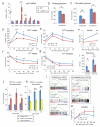Lin28a transgenic mice manifest size and puberty phenotypes identified in human genetic association studies
- PMID: 20512147
- PMCID: PMC3069638
- DOI: 10.1038/ng.593
Lin28a transgenic mice manifest size and puberty phenotypes identified in human genetic association studies
Abstract
Recently, genome-wide association studies have implicated the human LIN28B locus in regulating height and the timing of menarche. LIN28B and its homolog LIN28A are functionally redundant RNA-binding proteins that block biogenesis of let-7 microRNAs. lin-28 and let-7 were discovered in Caenorhabditis elegans as heterochronic regulators of larval and vulval development but have recently been implicated in cancer, stem cell aging and pluripotency. The let-7 targets Myc, Kras, Igf2bp1 and Hmga2 are known regulators of mammalian body size and metabolism. To explore the function of the Lin28-Let-7 pathway in vivo, we engineered transgenic mice to express Lin28a and observed in them increased body size, crown-rump length and delayed onset of puberty. Investigation of metabolic and endocrine mechanisms of overgrowth in these transgenic mice revealed increased glucose metabolism and insulin sensitivity. Here we report a mouse that models the human phenotypes associated with genetic variation in the Lin28-Let-7 pathway.
Figures




Similar articles
-
Investigation of peripubertal expression of Lin28a and Lin28b in C57BL/6 female mice.Mol Cell Endocrinol. 2013 Jan 30;365(2):241-8. doi: 10.1016/j.mce.2012.10.025. Epub 2012 Nov 5. Mol Cell Endocrinol. 2013. PMID: 23138112 Free PMC article.
-
Sex-specific regulation of weight and puberty by the Lin28/let-7 axis.J Endocrinol. 2016 Mar;228(3):179-91. doi: 10.1530/JOE-15-0360. Epub 2015 Dec 23. J Endocrinol. 2016. PMID: 26698568 Free PMC article.
-
The Lin28/let-7 axis regulates glucose metabolism.Cell. 2011 Sep 30;147(1):81-94. doi: 10.1016/j.cell.2011.08.033. Cell. 2011. PMID: 21962509 Free PMC article.
-
Lin28 gene and mammalian puberty.Mol Reprod Dev. 2020 May;87(5):525-533. doi: 10.1002/mrd.23347. Epub 2020 May 3. Mol Reprod Dev. 2020. PMID: 32363678 Review.
-
Lin28/let-7 axis in breast cancer.Mol Biol Rep. 2025 Mar 14;52(1):311. doi: 10.1007/s11033-025-10413-6. Mol Biol Rep. 2025. PMID: 40085362 Review.
Cited by
-
RNA Binding Proteins as Potential Therapeutic Targets in Colorectal Cancer.Cancers (Basel). 2024 Oct 16;16(20):3502. doi: 10.3390/cancers16203502. Cancers (Basel). 2024. PMID: 39456596 Free PMC article. Review.
-
A branched heterochronic pathway directs juvenile-to-adult transition through two LIN-29 isoforms.Elife. 2020 Mar 30;9:e53387. doi: 10.7554/eLife.53387. Elife. 2020. PMID: 32223899 Free PMC article.
-
[Recent advances in the genetic etiology of central precocious puberty].Zhongguo Dang Dai Er Ke Za Zhi. 2024 Mar 15;26(3):302-307. doi: 10.7499/j.issn.1008-8830.2309098. Zhongguo Dang Dai Er Ke Za Zhi. 2024. PMID: 38557384 Free PMC article. Review. Chinese.
-
Screening and evaluating of long noncoding RNAs in the puberty of goats.BMC Genomics. 2017 Feb 14;18(1):164. doi: 10.1186/s12864-017-3578-9. BMC Genomics. 2017. PMID: 28196477 Free PMC article.
-
Lin28 and let-7 in cell metabolism and cancer.Transl Pediatr. 2015 Jan;4(1):4-11. doi: 10.3978/j.issn.2224-4336.2015.01.05. Transl Pediatr. 2015. PMID: 26835354 Free PMC article. Review.
References
-
- Sulem P, et al. Genome-wide association study identifies sequence variants on 6q21 associated with age at menarche. Nat Genet. 2009 - PubMed
-
- He C, et al. Nat Genet. 2009
Publication types
MeSH terms
Substances
Associated data
- Actions
Grants and funding
LinkOut - more resources
Full Text Sources
Other Literature Sources
Molecular Biology Databases
Research Materials
Miscellaneous

